- Home
- Waterfront Law
- Examples of Our Team's Work in Virginia's Waterways

Ramone Photography
Water & Riparian Rights Law Experience with Virginia Waterway Laws
We work in one of the longest and most diverse coastlines in the world - 7,213 miles – over three times the distance between Virginia Beach and San Diego. Virginia is also home to numerous rivers and tributaries, and a great variety of wetlands. These waterways include:
Although no two cases are alike, click on the links above to see examples of our work helping Virginians in the waterways of Virginia.
Atlantic Ocean:
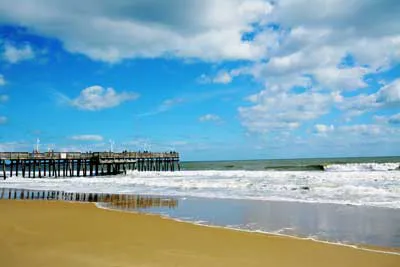
Atlantic Ocean
Shutterstock.com
The Atlantic is the second largest of the world’s oceans. It connects North America to Europe and Africa, and is a vital pathway for international shipping and commerce. It is also an abundant source of food which supports Virginia’s multi-million dollar aquaculture industry, and a recreation area for beachgoers and oceanfront property owners . Our team’s extensive knowledge of waterfront (riparian) property rights law, maritime and admiralty law, and environmental law helped clients in matters such as:
- Representing homeowners in Sandbridge Beach whose properties were being swallowed by encroaching sand dunes. Our efforts convinced local authorities to make commonsense changes in the law, resulting in revised environmental regulations which protect the rights of beachfront homeowners while still preserving the natural beauty of the dunes and defusing prosecutions brought under the Coastal Primary Sand Dunes and Beaches Act (this statute prohibits any disturbance of a primary sand dune without a permit; violation is a Class 1 misdemeanor, and can result in a civil penalty up to $25,000 for each day of violation)
- Salvage proceedings involving the RMS TITANIC, the ship that went down after hitting an iceberg in 1912 on its maiden voyage from Southampton, England to New York, New York
- Assisting commercial fishing entities in multiple commercial fishing quota actions against the National Marine Fisheries Service resulting in increased catch limits
- Successfully assisted a commercial fishing fleet owner in retaining a federal scallop permit, valued in excess of $500,000.00, against challenge brought by a commercial competitor
- Contract negotiations for shipyards, including a long-haul towage contract for a large dry dock traversing the Mississippi River, Gulf of Mexico, and the Atlantic Ocean off the eastern seaboard
- Represented several commercial fishing fleet owners defending Jones Act claims for personal injuries brought by vessel crew members
Read More Atlantic Ocean Cases
Chesapeake Bay:
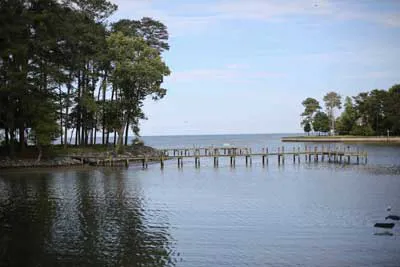 Chesapeake Bay
Chesapeake Bay
Shutterstock.com
Covering an area of over 200 square miles, the Chesapeake Bay is the largest estuary in the United States and one of the largest in the world. Most of the rivers and tributaries in the Commonwealth flow into the Chesapeake Bay. Although it is still a rich source of fish, clams, and oysters, these fisheries have experienced great harm from the pollution created by the 17 million people who live along the Bay. Thankfully, water quality in the Bay has improved of late, and the shellfish harvest is once again on the rise. Some examples of our work on the Bay include:
- Assisted a waterfront property owner who demolished a residence located within the Resource Protection Area (RPA) of the Chesapeake Bay Preservation Act.Penalties for violating the Act can be severe, with fines up to $5,000 for each day of violation. We assisted the owner in tailoring a design that resulted in approval for re-building without moving entirely outside the RPA.
- Oyster lease permit hearings at the Virginia Marine Resources Commission (VMRC), including representing riparian property owners protesting the installation of an industrial-sized floating oyster aquaculture farm in Hungars Creek, which flows into the Bay from the Eastern Shore
- Helping a commercial client resolve an environmental enforcement action brought by the Virginia Department of Environmental Quality after the inadvertent release of 1,700 gallons of toxic chemicals into the Bay during a construction project, in violation of the Virginia State Water Control Law
- Provided an expert legal opinion to help resolve a waterfront property ownership dispute relating to Old Point Comfort near historic Fort Monroe
- Represented several commercial fishing fleet owners defending Jones Act claims for personal injuries brought by vessel crew members
Read More Chesapeake Bay Cases
Chincoteague Bay:
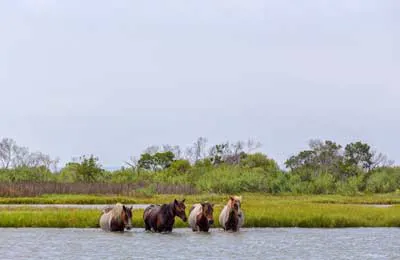 Chincoteague Bay
Chincoteague Bay
Shutterstock.com
Chincoteague Bay is located on the Atlantic Ocean side of the Eastern Shore, between Accomack County and the barrier islands of Assateague and Chincoteague. Chincoteague Island is famous for its picturesque beauty and its annual wild pony roundup. Our cases around Chincoteague Bay include:
- Defending a waterfront property owner on Chincoteague Island against a trespass accusation, and assisting him in obtaining a permit to build a pier
- Represented builder of the Chincoteague bridge in Federal Court after local watermen claimed that oyster and clam beds were buried in silt and thereby destroyed during bridge construction.
Read More Chincoteague Bay Cases
Elizabeth River:
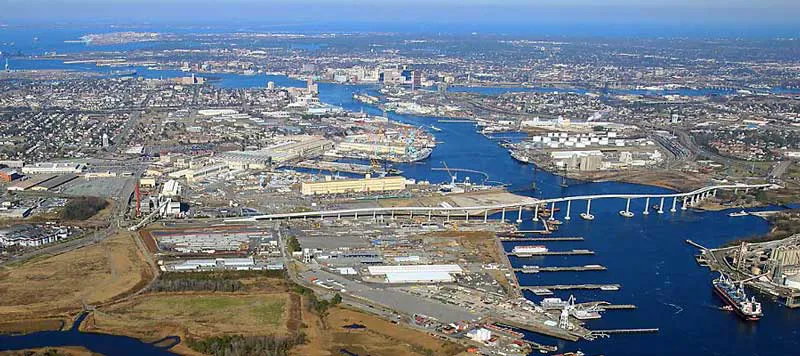
US Army Corps of Engineers
Draft Integrated City of Norfolk Coastal Storm Risk Management Feasibility Study / Environmental Impact Statement (Figure 10-36)
Although only 6 miles long, the Elizabeth River is one of the most important waterways in the world. Located at the southern end of the Chesapeake Bay, it lies between the port cities of Portsmouth and Norfolk and forms the core of the Hampton Roads Harbor. It is also a gateway to the Atlantic Intracoastal Waterway, which runs up and down the east coast from Boston to the southern tip of Florida. The Elizabeth River is badly damaged from centuries of industrial pollution and stormwater runoff. The health of the river is improving due, in significant part, to the work of The Elizabeth River Project. Examples of our team’s work on the Elizabeth include:
- Assisted a waterfront commercial property owner in complying with the Virginia Tidal Wetlands Act, which governs coastal areas between mean low water and mean high water, after he received a Notice of Violation issued by the City of Norfolk
- Appeared before the Virginia Marine Resources Commission in a successful effort to block installation of a large mooring facility that would have devalued our client's riparian property rights
- Numerous litigation actions representing marine terminals and shipyards in personal injuries to longshoremen and harbor workers, and cargo damage actions
- Defense of multiple federal and state workers compensation claims brought against marine terminals, intermodal operators, and marine construction companies
- Multiple suits involving vessel allisions with marine terminals and bridges
- Defense of Jones Act claim brought by crew member after vessel sank in the river
- Successful prosecution of a wake damage claim after a USCG Cutter generated a large wake causing property damage on a derrick barge that was in the midst of a heavy lift
- Commercial property disputes, such as filing a citizen's environmental lawsuit in Federal Court under the federal Clean Water Act to force the removal of a “floating junkyard” of hulking vessels which were blocking access to a client’s waterfront business
- Advocating for the rights of property owners to construct private piers at their residence
- Environmental clean-up. For example, in 2016, Jim led a team of over 50 “Restore the Shore” volunteers from the Virginia law firm Pender & Coward, P.C. the Elizabeth River Project, the City of Norfolk, and the Boy Scouts in a successful effort to bring a battered section of shoreline of the Elizabeth River back to life.
Read More Elizabeth River Cases
James River:
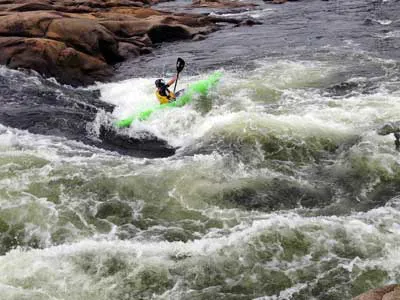 James River
James River
Shutterstock.com
The James River is the largest watershed in Virginia. It begins in the Appalachian Mountains and flows nearly 350 miles to the Chesapeake Bay, where it joins with the Elizabeth and Nansemond Rivers to form Hampton Roads Harbor. Richmond, the state capital, is located on the James, and Jamestown, America’s first permanent English colony, was settled on its banks. The James is a well-known fishing hotspot. It was the site of several Bass Master Classics and the 2003 FLW Tour Championship. The James also offers excitement and adventure to boaters, swimmers and white water rafters. A two-mile stretch through downtown Richmond is the only place in the country where class III and IV whitewater rapids exist within sight of skyscrapers. Our work on the James includes:
- Helped riparian property owners resolve a Chesapeake Bay Preservation Act enforcement action brought by the City of Richmond after the owners re-landscaped their yard. The enforcement authority was demanding a restoration plan that would have cost $150,000 and civil penalties. The case was resolved with the enforcement authority agreeing to accept the common sense restoration proposed by the homeowners and agreeing to forego civil penalties.
- Drafted marine construction contract governing use of derrick barges during construction of electrical transmission towers spanning the James River
- Represented several commercial fishing fleet owners defending Jones Act claims for personal injuries brought by vessel crew members
Read More James River Cases
Lynnhaven River:
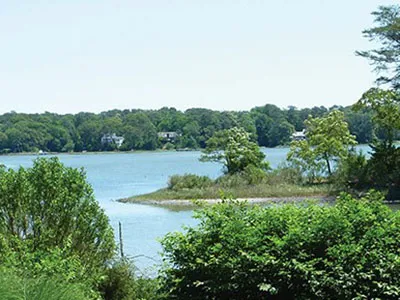 Lynhaven River
Lynhaven River
LNRNow, Virginia Beach
The Lynnhaven River is a tidal estuary located in Virginia Beach. It flows into the Chesapeake Bay at Lynnhaven Inlet. The river is known for the world-famous Lynnhaven oyster, considered by many to be the best oyster in the world. In past decades the Lynnhaven oyster population has declined dramatically, primarily due to man-made pollution. However, thanks to restoration efforts such as the “Lynnhaven River Now” project, the water quality is improving and the oyster population is once again on the rise. Examples of our work on the Lynnhaven include:
- Advocating for the rights of property owners to construct piers on the Lynnhaven River and in the Lynnhaven Bay
- Assisting waterfront residential homeowners who want to restore navigation channels at their property through the City of Virginia Beach's Navigational Channel Dredging Program
- Representing waterfront property owners who object to oyster farming in residential areas that are incompatible with this type of operation
Read More Lynhaven River Cases
Piankatank River:
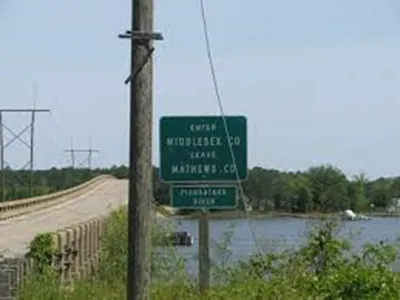 Piankatank River
Piankatank River
Janice Vogel, Mathews, Virginia
The Piankatank River is located on the Middle Peninsula, between the Rappahannock and York rivers. History buffs know the river as the site of numerous Civil War battles. More recently, the Piankatank has been named one of several Chesapeake Bay tributaries to be targeted by state and federal authorities for large-scale efforts to restore the once-bountiful oyster population. Our cases on the Piankatank include:
- Environmental litigation, including advocating for a shipyard owner in a dispute involving the Comprehensive Environmental Response Compensation and Liability Act (“CERCLA”). Under CERCLA, multi-million dollar clean up costs may be retroactively imposed for hazardous substances disposed of years ago, even if the disposal was done by a previous owner at a time when it was perfectly legal
- Property disputes, including the defense of a claim for a maritime equitable easement asserted against a shipyard
- Appearing before the Virginia Marine Resources Commission and asserting claims at the U.S. Army Corps of Engineers on behalf of waterfront residential property owners who oppose construction of an industrial sized-oyster operation in scenic Milford Haven, the site of a Revolutionary War naval battle and a highly popular tourist destination
Read More Piankatank River Cases
Potomac River:
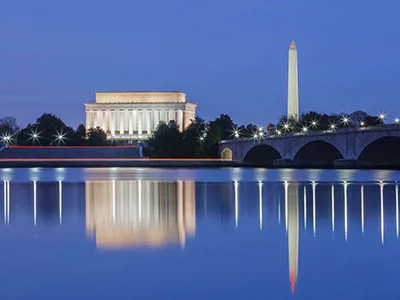 Lincoln memorial and Washington Monument reflecting on the water of the Potomac River
Lincoln memorial and Washington Monument reflecting on the water of the Potomac River
Cvandyke/Shutterstock.com
Although the Potomac is over 400 miles long, it is probably best-known as the river that flows through our nation’s capital, separating Maryland from Washington, D.C. Some of our most iconic monuments, including the Jefferson Memorial and Mount Vernon, sit along its banks. Some examples of our work in the Potomac include:
- Representing riparian property owners in disputes ranging from easements to trespass, to the construction of private piers
- Assisted a client in protecting property rights at a privately owned island in the river used for duck hunting
Read More Potomac River Cases
Rappahannock River:
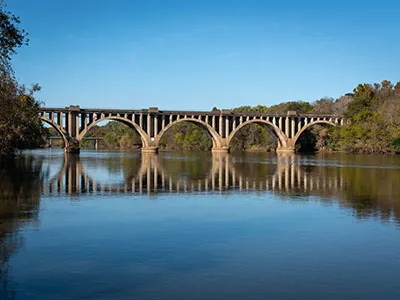 Rappahannock River at Fredericksburg, Virginia
Rappahannock River at Fredericksburg, Virginia
Photosbyandy/Shutterstock.com
The Rappahannock is 195 miles long. It begins in the Blue ridge mountains in the western part of the Commonwealth, and traverses the entire state until it ends in the Chesapeake Bay. Some of the earliest colonial settlements were formed along the Rappahannock, and it was the site of a major battle in the American Civil War. Our team’s work on the Rappahannock includes:
- Representing waterfront property owners in proceedings at the Virginia Marine Resources Commission to stop an 11 acre industrial oyster farming projects in a location not suited for this type of aquaculture
Read More Rappahannock River Cases
York River:
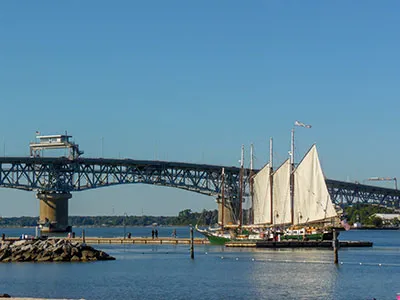 Sailboat on York River below the George P. Coleman bridge
Sailboat on York River below the George P. Coleman bridge
V-ron/Shutterstock.com
The York River begins at West Point, approximately 35 miles east of Richmond. The river is 34 miles long, ending in the Chesapeake Bay near Yorktown, which sits along the river’s southern shore. Some of our work on the York River includes:
- Represented a bridge owner after a tugboat allided with the Coleman Bridge, causing extensive damage to the bridge and a million dollar plus recovery for our client
Read More York River Cases
Northwest River:
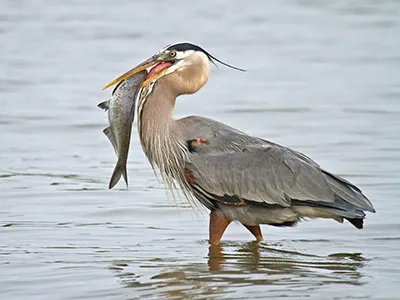 Great Blue Heron With Fish
Great Blue Heron With Fish
LorraineHudgins/Shutterstock.com
Located in Chesapeake, Virginia, the Northwest River is one of the few rivers in the Tidewater area that does not flow directly into the Chesapeake Bay. The Northwest River is a ”blackwater” river that drains eastward from the Great Dismal Swamp. Our cases on the Northwest River include
- Assisted a property owner in complying with the wetlands provision in the federal Clean Water Act after he received an Administrative Compliance Order issued by the EPA
Read More Northwest River Cases
Atlantic Intracoastal Waterway("AICW" or "The Ditch"):
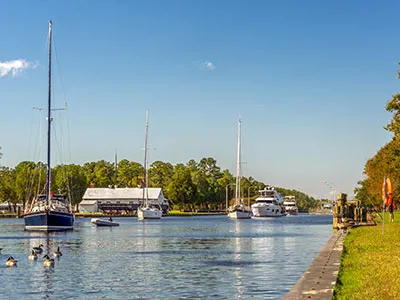 Boats exiting the Great Bridge Locks in Chesapeake, Virginia on the Inter-Coastal Waterway heading south to North Carolina
Boats exiting the Great Bridge Locks in Chesapeake, Virginia on the Inter-Coastal Waterway heading south to North Carolina
JoMo333/Shutterstock.com
Norfolk, Virginia is mile marker zero for the Atlantic Intracoastal Waterway, a 3,000-mile waterway along the Atlantic and Gulf coasts of the United States running from Norfolk to Miami. The AICW provides a navigable route for commercial and recreational vessels that avoids the hazards of the open sea. The Albemarle and Chesapeake Canal is part of that system and holds the distinction of being one of the earliest American canals.
- Assisted a marina owner on the Albemarle and Chesapeake Canal with an easement issue that was threatening his business.
Read More AICW Cases
Riparian Rights: Waterfront Property Virginia
Jim Lang and his team at Pender & Coward, P.C. work hard to protect the rights of Virginians who live, work, and play on the 3,285 square miles of water in the Commonwealth of Virginia. Jim and his team have decades of experience taking care of people like you throughout Virginia in all matters related to waterfront (riparian) property rights, maritime & admiralty law, and environmental law.
Are you looking for experienced Waterfront Lawyers to represent you?
Client Testimonials
REAL ESTATE INVESTOR IN VIRGINIA BEACH VA
Thank Trust and heart are the two words that I will use to describe working with Jim Lang. I trust Mr. Lang to do a great job for me, and let me know up front what my legal fees will total. In the past, he has given me the option to do some of the legal work myself in order to stay within my budget. Mr. Lang also has a heart. He understands life's many ups and downs. I felt that he was really on my side, that he was concerned about me, and how I was doing with my new business. Mr. Lang is an outstanding lawyer but more importantly, Mr. Lang is a good man. I highly recommend him.
- Liz R.SMALL BUSINESS OWNER IN VIRGINIA BEACH VA
Jim Lang has represented my company and myself in litigation several times. These were events that occurred at years of doing business of no fault of my own. I can not express the relief of having Jim by my side. The courtroom is not a place I like to find myself. He was very knowledgeable, professional, and understanding. He explained all my options and even what was going to occur before it happened. He knew what opposing council was going to do like as if he read their notes. I never at any time felt my decision for him to represent me was a wrong decision. I know sometimes life has a way of creating issues beyond your control. These issues can be handled in and a lot of times out of court. I know as long as James (Jim) Lang is my attorney I sleep better at night for those what if's life sometimes throws at you.
- David M.CONSTRUCTION COMPANY OWNER CHARGED WITH WETLANDS VIOLATION IN CHESAPEAKE VA
Thank you so much Bryan Peeples, attorney for Pender and Coward for representing my company in a legal matter. The situation was handled in a timely, professional way and we are so happy with the positive outcome!! We would highly recommend Mr. Peeples and the firm of Pender and Coward to anyone needing sound, legal representation. Great job!!!
- Gary S.LITIGATION INVOLVING LARGE PIER ON POTOMAC RIVER IN LORTON VA
Hi Jim and Jeff, Yay!! Thank you, thank you, thank you! . . . I can't tell you how relieved I am and how much I appreciate your efforts on our behalf! . . . Jim and Jeff, we always were confident that we found, not only the right attorneys in you, but also true advocates for our case. Thank you so much for your diligence and for the thoughtful and thorough way you represented us!
- Mary S.HELPED CLIENTS BUILD PIER ON THE EASTERN SHORE VA
My husband, Paul, and myself cannot say enough good things about our experience with Pender and Coward. We worked with James Lang and Jeff Wilson on a rather complicated issue that we were not sure we could get a solution to. However, because of their professionalism, their vast knowledge and the ease with which they worked with us, it ended up to be a great success story. They were able to handle something a bit out of the norm and helped us achieve our goal without the issue escalating. They listened and actually heard us and their communication was always immediate and personal. We can't thank them enough. They lifted a huge weight off our shoulders and we are forever grateful.
- Louisa FWATERFRONT PROPERTY RIGHTS FOR REALTORS ASSOCIATION IN VIRGINIA BEACH VA
Your presentation (plus Tom’s) was one of the most important educational sessions I’ve attended in my 30+ years in real estate. I sincerely value your good advice.
- Betty Moritz Associate Broker, BHHS Towne Realty Liz R.Contact Our Team of Experienced Lawyers
Fill in the information (to the right) to reach Jim Lang and his team.
Contact Jim Lang
Email: jlang@pendercoward.com
Phone: (757) 502-7326
Maritime Emergency?
Call or text Tom Berkley 24 hours a day
Phone: (757) 572-2657